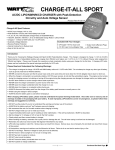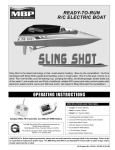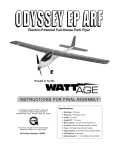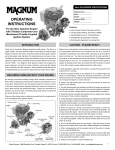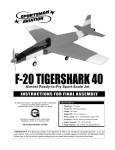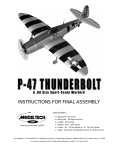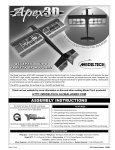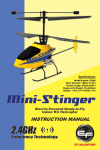Download Wind Craft 128296 Operating instructions
Transcript
HTTP://WATT-AGE.GLOBALHOBBY.COM OPERATING INSTRUCTIONS SPECIFICATIONS AND FEATURES: The Wattage Wind Craft RTF R/C Kite-Plane is distributed exclusively by Global Hobby Distributors 18480 Bandilier Circle, Fountain Valley, CA 92708 All contents copyright © 2004, Global Hobby Distributors Version V3.0 September 2004 Kit Product Numbers: 128295 & 128296 ● Kite Wing Span: 26.25 Inches ● Kite Wing Area: 270 Square Inches ● Length: 19.5 Inches ● Weight RTF: 6.5 Ounces ● Kite Wing Loading: 3.5 Ounces Per Square Foot ● Dual Motor Control for Direction and Altitude ● Rechargeable 5 Cell Flight Battery ● Installed 2-Channel Radio System ● Composite Kite Wing Frame for Strength and Low Weight ● 110V AC 2 Hour Flight Battery Charger ● Replacement Parts Available ✦ IMPORTANT✦ ✦ Before beginning assembly, please read and understand the warnings listed on the next page. Failure to do so could lead to bodily harm and/or injury. The Wattage Wind Craft RTF R/C Kite-Plane is not intended for those under 12 years of age, unless closely supervised by an adult. 1 FOR YOUR SAFETY - PLEASE READ AND UNDERSTAND THESE WARNINGS! FLIGHT BATTERY WARNINGS GENERAL WARNINGS Never overcharge the flight battery or damage to the flight battery may occur. Do not fly your kite-plane if another kite-plane or other airplane is on the same frequency as you. The frequency number is printed on the radio transmitter. ● ● To prevent the flight battery from overheating during the charging process, allow the flight battery to completely cool before recharging it. ● Never fly your kite-plane from the street or at night. Always fly in an open area free of obstructions. ● ● Always completely discharge the flight battery by running the motors until they stop, before recharging the flight battery. When flying, make sure any spectators are behind you. ● Always be conscious of the spinning propellers. Be careful not to allow loose clothing to be drawn into the propellers. ● RADIO SYSTEM WARNINGS Because your kite-plane is operated by radio control, it is important to make sure you are always using fresh and/or fully charged batteries. Never allow the batteries to run low or you could lose control of the kite-plane. ● Always turn on the transmitter before turning on the kite-plane and always turn off the kite-plane before turning off the transmitter. ● Always unplug the flight battery when not flying the kite-plane. ● Never attempt to disassemble any of the kite-plane's components, especially the transmitter and flight battery. ● Never cut the receiver antenna shorter or you could lose control of the kite-plane during flight. ● Do not allow any of the components to get wet or electrical damage may occur. ● When flying the kite-plane, make sure the transmitter antenna is completely extended. ● You should complete a successful range check of your radio equipment prior to each new day of flying, or prior to the first flight of a new or repaired kite-plane. ● Never attempt to disassemble or modify any of the radio system components. ● If your kite-plane gets dirty, do not use any solvents to clean it. Solvents will damage the plastic and nylon kite wing material. Use a dry cloth to clean any dirt from the outside of the fuselage pod and a damp cloth to clean the nylon kite wing material. ● FOR YOUR INFORMATION If you should have any trouble with any of the steps listed in these operating instructions, we have provided a troubleshooting guide on page # 17. The troubleshooting guide is provided to help you find a quick and immediate resolution to any number of problems that might occur. If you cannot solve a problem using the troubleshooter, or if you have any other questions or concerns, please contact us using the information below: On the Web http://globalservices.globalhobby.com http://watt-age.globalhobby.com Global Services 18480 Bandilier Circle Fountain Valley CA 92708 Phone: (714) 963-0329 Fax: (714) 964-6236 Email: [email protected] OUR GUARANTEE Wattage guarantees this kit to be free from defects in both material and workmanship at the date of purchase. This does not cover any component parts damaged by use, misuse or modification. In no case shall Wattage's liability exceed the original cost of the purchased kit. In that Wattage has no control over the final assembly or material used for final assembly, no liability shall be assumed for any damage resulting from the use by the user of the final user-assembled product. By the act of using the final user-assembled product, the user accepts all resulting liability. 2 INTRODUCTION Thank you for purchasing the Wattage Wind Craft RTF R/C Kite-Plane. Before completing the final assembly of your new kite-plane, please carefully read through these operating instructions in their entirety. Doing so will ensure your success the first time around! The Wind Craft RTF R/C Kite-Plane from Wattage makes R/C easy, fun and versatile. The Wind Craft RTF R/C Kite-Plane is a complete, ready-to-fly aircraft requiring only a few minutes to assemble (using the included screwdriver) and 8 AA alkaline batteries for the transmitter. The Wind Craft RTF R/C Kite-Plane uses a special 5 cell rechargeable flight battery and 110 volt AC charger that is included. And it's available on two different frequencies, so you can fly with your friends even if they are flying the Wattage Tigershark! Takeoff and land from the ground, fly in small areas, learn to control your Wind Craft RTF R/C Kite-Plane with precision and you'll be tearing up the skies and completing daring low-altitude maneuvers! You can do it because the Wind Craft RTF R/C Kite-Plane's reliable dual-propeller directional control, kite-style wing and very low weight provide incredible stability, predictability and control. In short, the Wind Craft RTF R/C Kite-Plane is easy and fun to fly! Remember, we also offer extra batteries, fast battery chargers, replacement parts and a great service department with public discussion forums to meet your customer service needs. SECTION 1: PARTS IDENTIFICATION Before beginning assembly, remove the different parts from the box and use the photos below to verify that your kit contains all of the correct parts. If your kit is missing a part, please contact us immediately, using the contact information listed on the bottom of page # 2. Transmitter Fuselage Pod Assembly w/Motors Kite Wing Assembly Flight Battery Charger Screws & Washers (2 ea.) Flight Battery Propellers (4) Spare Plastic Fittings & Screws Screwdriver & Ribbon 3 SECTION 2: RECOMMENDED ITEMS This section lists the items you will need to fly your new Wind Craft RTF R/C Kite-Plane. As you can see, there's not much to it! ● 8 Pack Trinity AA Alkaline batteries for the transmitter Part # 837801 PRO TIP The Wattage Wind Craft RTF R/C Kite-Plane includes a 5 cell Nickel Metal-Hydride flight battery and a 2.5 hour AC wall charger to charge the flight battery. If you want to, you can purchase a second flight battery so you have two. That way, you can take two fully-charged flight batteries with you to fly. That means twice as much flying fun! We also sell a high-performance quick-charger that can charge the flight battery in about 30 minutes and is powered from your car's 12 volt DC battery. This enables you to charge the flight battery at the flying field, so you can fly as many times during the day as you want. Wattage PF-12 AC/DC Peak Charger Part # 130108 SECTION 3: BECOMING FAMILIAR WITH YOUR WIND CRAFT RTF R/C KITE-PLANE The Wind Craft RTF R/C Kite-Plane is available on two different radio frequencies - Channel 1 and Channel 2. No two kite-planes can operate nearby each other if they are on the same frequency. Note that these two frequencies are different from the two different frequencies that the Wattage Tigershark RTF uses. This allows you to fly the Wind Craft RTF R/C Kite-Plane and the Tigershark RTF at the same time. Antenna: Transmits the signal from the transmitter to the receiver inside the kite-plane. Battery Condition Lights: Indicates the condition of the 8 AA Alkaline transmitter batteries. The green LED glows to indicate good battery condition and the red LED glows to indicate inputs from the transmitter. When the batteries are depleted to the point they're unsafe to use, an audio alert will sound from the transmitter. Battery Cover: Plastic cover that holds the 8 AA Alkaline batteries in place. Motor Speed Up/Down Stick: Used to make the kite-plane climb. Pushing the stick forward turns the motors on, which makes the kite-plane climb. Letting go of the stick turns the motors off, which allows the kite-plane to descend. On/Off Switch: Turns the transmitter on and off. When the transmitter is on, the battery LED will glow green. Turn Right/Left Stick: Used to steer the kite-plane. Pushing the stick left or right causes the kite-plane to turn left or right. 4 Continued On Next Page ☛ BECOMING FAMILIAR WITH YOUR WIND CRAFT RTF R/C KITE-PLANE, CONTINUED.... Note: Photo Above May Differ From Production Model Antenna Wire: Receives the signal from the transmitter and relays it to the receiver inside the kite-plane. The antenna wire is secured to the front of the kite wing assembly, so that it doesn't get caught in the propellers. Never cut off the excess antenna wire or you can lose control of the kite-plane in a very short distance. Battery Door: A plastic cover that holds the flight battery in place. Fuselage Pod: The main body of the kite-plane. All of the main assemblies are attached to the fuselage pod. Motor: The motor provides power to the propeller, which in turn creates thrust and makes the kite-plane fly. The Wind Craft RTF R/C Kite-Plane has two motors. On/Off Switch: When turned on, the switch allows power to the motors and the electronics inside the fuselage pod. Propeller: The propeller is attached to the back of the motor. When spinning, the propeller creates thrust which pushes the kite-plane forward. Kite Wing Assembly: The kite wing assembly is comprised of high-strength nylon material and carbon-fiber dowels for light weight and high strength. The kite wing assembly provides the main source of lift for the kite-plane. Landing Gear: Comprised of wire and three wheels, the landing gear supports the kite-plane while on the ground. Now that you're familiar with your new Wattage Wind Craft RTF R/C Kite-Plane, it's time to finish the assembly and get flying! WARNING The flight battery included with your Wind Craft RTF R/C Kite-Plane comes from the factory partially charged. DO NOT charge the flight battery until after testing the motors. This will ensure that the flight battery is run down completely before recharging it. This is important to ensure that the flight battery receives a full charge and is cycled before your first flight. 5 SECTION 4: ASSEMBLING YOUR WIND CRAFT RTF R/C KITE-PLANE STEP 1: INSTALLING THE TRANSMITTER BATTERIES ❑ Carefully remove the battery cover from the front of the transmitter by pulling down on it with one hand while holding the transmitter with your other hand. ❑ Install 8 fresh AA Alkaline batteries, being careful to make sure that the polarity is correct for each battery. PRO TIP If you use rechargeable AA NiCD cells, double-check to make sure that they are fully charged before installing them into the transmitter. Never attempt to charge or recharge Alkaline cells. ❑ After double-checking that the batteries are installed correctly, reinstall the battery cover, making sure it's firmly seated into place. STEP 2: OPENING THE KITE WING ASSEMBLY ❑ Lay out the kite wing assembly upside down and carefully twist the carbon-fiber brace, so that it's perpendicular to the carbon-fiber center brace. 6 Continued On Next Page ☛ ❑ Carefully snap the plastic connector on each end of the carbon-fiber brace onto the plastic post on each side of the kite wing assembly. ✦ IMPORTANT✦ ✦ Make sure that the connectors snap firmly onto the plastic posts. ❑ Rotate each of the two plastic supports 90º and make sure that they lock into place. ✦ IMPORTANT✦ ✦ It's important that the two plastic supports are locked into place. These supports prevent the kite wing material from falling into the spinning propellers during flight. STEP 3: INSTALLING THE KITE WING ASSEMBLY ONTO THE FUSELAGE POD ❑ Slide the back of the plastic kite wing mount (on top of the fuselage pod) between the two metal wires that are attached to the kite wing assembly. 7 Continued On Next Page ☛ ❑ Firmly push the plastic post in the front of the kite wing mount into the hole in the corresponding plastic mount on the kite wing assembly. ✦ IMPORTANT✦ ✦ Make sure to push the post into the hole completely, as shown. ❑ Line up the hole at the back of the kite wing mount with the corresponding hole in the plastic mount on the kite wing assembly. ❑ Secure the kite wing assembly to the kite wing mount, using one small (6mm long) self-tapping screw and one flat washer. Tighten the screw firmly, using the phillips head screwdriver provided. ✦ IMPORTANT✦ ✦ When installed properly, the back of the kite wing mount should be in front of the plastic mount on the kite wing assembly, as shown above. If it's not, the plastic post at the front of the kite wing mount is not pushed completely into the corresponding hole on the kite wing assembly. ❑ Line up and secure the base of the two metal wires to the corresponding hole in the back of the fuselage pod assembly, using one large (11mm long) machine screw and one flat washer. Tighten the screw firmly, using the phillips head screwdriver provided. ✦ IMPORTANT✦ ✦ The hole in the base of the two wires is elongated. When threading the machine screw into place, make sure to keep the slot centered. 8 Continued On Next Page ☛ STEP 4: ROUTING THE ANTENNA ❑ Uncoil the receiver antenna and secure it under the two plastic fasteners located on the carbon-fiber center brace. ❑ Pull the antenna taut, then feed the end of it up through one of the small predrilled holes in the plastic mount at the very front of the kite wing assembly. Allow the excess antenna to hang out the front of the kite wing assembly. ✦ WARNING✦ ✦ Under no circumstances should you cut the receiver antenna shorter. Allow the excess to hang out the front of the kite wing assembly. Cutting the receiver antenna can greatly shorten the range of the radio control system. STEP 5: INSTALLING THE FLIGHT BATTERY ✦ WARNING✦ ✦ Do not charge the flight battery before installing it. Charging will be done later. ❑ Remove the plastic battery door from the bottom of the fuselage pod by carefully pulling forward, then up, on the latch at the back of the battery door. ✦ WARNING✦ ✦ Before plugging in the flight battery, verify that the On/Off switch on the bottom of the fuselage pod is in the "off" position. ❑ Plug the connector on the flight battery into the connector that is inside the fuselage pod. When plugged in properly the connectors should "click" together. ✦ IMPORTANT✦ ✦ As a safety feature, the connectors can only be plugged in one way. 9 Continued On Next Page ☛ ❑ Push the connectors and wires into the back of the fuselage pod, then push the flight battery down into the fuselage pod, making sure that the cloth tab on the flight battery is toward you, so that you can grab it easily. ✦ The fuselage pod is molded to fit the ✦ IMPORTANT✦ flight battery. The flight battery will fit properly only one way. The wider, flat side should be toward you, as shown. PRO TIP The cloth tab that is attached to the flight battery allows you to easily remove it for charging, by simply grabbing and pulling on the tab. ❑ Reinstall the battery door, making sure that the plastic latch "snaps" firmly into place. STEP 6: INSTALLING THE PROPELLERS ❑ Carefully install one propeller onto each motor shaft. To install the propellers correctly, simply push them firmly onto the motor shaft. PRO TIP Two extra propellers have been included should you break one during landing. We suggest keeping the extras with you while you're flying, just in case. Now that you're done assembling your Wind Craft RTF R/C Kite-Plane, it's time to learn how it's controlled and how to fly it. That's done in the next section. 10 SECTION 5: LEARNING TO FLY YOUR WIND CRAFT RTF R/C KITE-PLANE Step 1: Basic Operation Before actually flying your Wind Craft RTF R/C Kite-Plane you should understand how the kite-plane is controlled. Below we list the four basic flight modes: Climb: Climbing is controlled by pushing the Motor Speed Up/Down Stick on the transmitter. This is the stick on the left side of the transmitter that moves up and down. When you push the stick forward (toward the top of the transmitter), both motors turn on at high speed and the kite-plane climbs. Descent: Descent is also controlled by the Motor Speed Up/Down Stick. When the stick is released, the motors turn off completely and the kite-plane begins to descend gradually. PRO TIP While the Motor Speed Up/Down Stick can be pulled backward, we don't recommend doing this, because it may add confusion during flight. Right Turn: A right turn is done by moving the Turn Right/Left Stick on the transmitter. This is the stick on the right side of the transmitter. When you move the stick to the right, the right motor turns slower and the left motor stays at high speed. This makes the kite-plane turn right. Left Turn: A left turn is done by moving the Turn Right/Left Stick on the transmitter to the left. When you move the stick to the left, the left motor turns slower and the right motor stays at high speed. This makes the kite-plane turn left. Step 2: Ground Operations Testing Now that you're familiar with the four basic flight modes, you can test the radio control system and the motors while seeing first-hand how the motors turn on and off to make the kite-plane climb, descend, turn right and turn left. PRO TIP You'll want to do Ground Operations Testing until the flight battery no longer has enough power to operate the motors. This will allow you to become familiar with how the motors react to the inputs from the transmitter control sticks and it will prepare the flight battery for its first full recharge before flight. ❑ Begin by turning the on/off switch on the transmitter into the "ON" position, then turn the on/off switch on the bottom of the fuselage pod into the "ON" position. ✦ WARNING✦ ✦ When turning on the kite-plane, make sure your fingers and any loose clothing are clear of the propellers. Always turn on the transmitter before turning on the kite-plane. Conversely, always turn off the kite-plane before turning off the transmitter. ❑ While holding the kite-plane in the air (making sure your fingers and any loose clothing are clear of the propellers), push the Motor Speed Up/Down Stick forward. Both propellers will spin at a high rate of speed. This is how the kite-plane climbs. Let go of the stick and it will return to center on its own. At this point, the motors will turn off and the propellers will stop spinning. This is how the kite-plane descends. ❑ While still holding the kite-plane in the air, push the Turn Right/Left Stick to the right. The left propeller will spin at a high rate of speed and the right propeller will slow down. This is how the kite-plane turns right. Now push the Turn Right/Left Stick to the left. The right propeller will spin at a high rate of speed and the left propeller will slow down. This is how the kite-plane turns left. ❑ For this next procedure have someone else hold the kite-plane while you hold the transmitter with both hands. You can now move both sticks at the same time. This will allow you to make climbing turns to the right or left and descending turns to the right or left. As an example, to make a climbing right turn, hold the Motor Speed Up/Down Stick fully forward, then when you want to turn right, continue to hold the stick fully forward and move the Turn Right/Left Stick to the right. The kite-plane will now make a shallow climbing right turn. Using different stick combinations can make the kite-plane fly climbing and descending right and left turns. ❑ Continue the Ground Operations Testing until the flight battery no longer has enough power to operate the motors. Once this occurs, turn off the kite-plane and the transmitter, then remove the flight battery from the fuselage pod. 11 SECTION 6: GETTING READY TO FLY YOUR WIND CRAFT RTF R/C KITE-PLANE STEP 1: CHARGING THE FLIGHT BATTERY ✦ IMPORTANT✦ ✦ Before charging the flight battery, the flight battery must be fully discharged. Discharge the flight battery by running the motors until they stop. This will ensure that you don't overcharge the flight battery. If the flight battery is hot to the touch, it is fully charged. Unplug it from the charger immediately. ❑ Plug the flight battery connector into the battery charger connector. When plugged in properly the connectors should "click" together. PRO TIP As a safety feature, the connectors can only be plugged in one way. ❑ Plug the charger into a 110V AC wall outlet. ❑ Charge the flight battery for 2.5 hours. Be careful not to overcharge the flight battery. ❑ To unplug the connectors, squeeze the tab on the battery connector and pull the two connectors apart. ❑ After completely charging the flight battery, install it into the fuselage pod, using the same techniques as when you installed it previously. ✦ WARNING✦ ✦ Always remove the flight battery from the fuselage pod for the charging process. STEP 2: CHOOSING A DAY TO FLY ❑ Until you become a proficient flyer you should always plan on flying your kite-plane when there's no wind. We strongly suggest waiting for a calm day. If it's windy out and you attempt to fly, it will only make learning to fly the kite-plane more difficult. Once you are proficient at flying the kite-plane, you can fly the kite-plane in light winds - no more than 5-7 miles per hour. Flying in stronger winds is not recommended. STEP 3: CHOOSING YOUR FLYING FIELD ❑ The flying field you choose should be a large, open field with grass. There should not be any vehicles, buildings, power lines, trees, large rocks or anything else that your kite-plane can crash into. 12 Continued On Next Page ☛ Step 4: Range Testing the Radio System After getting out to your flying field, but before you fly for the first time, you must range test the radio system. This will ensure that the transmitter is "talking" correctly to the kite-plane. You should follow this procedure before every first flight of the day and after you have a hard landing, crash or after a repair. ❑ Turn on the transmitter, then turn on the kite-plane. ❑ Set the kite-plane on the ground and extend the transmitter's antenna completely. Move the sticks on the transmitter once to check the motors. They should turn on and operate smoothly. ❑ Walk approximately 75ft. from the kite-plane and move the sticks on the transmitter once more. Check to make sure that the motors are operating smoothly at this distance. You may need a friend to help you with this step. ✦ WARNING✦ ✦ If the kite-plane does not range check, don't fly! Please refer to the troubleshooting guide on page # 17. SECTION 7: YOUR FIRST FLIGHT After all this, I bet you're ready to actually go flying! If you've skipped anything prior to this section, we suggest going back through the instructions. Doing so will help ensure your success. WARNING***WARNING***WARNING***WARNING***WARNING***WARNING If at any time during your flight, the kite-plane gets stuck up in a tree, in power lines or on a roof top, DO NOT attempt to retrieve the kite-plane yourself. The kite-plane is not worth the risk. We strongly suggest contacting your local fire department for assistance. Attempting to retrieve the kite-plane yourself in any of these cases could potentially result in extreme harm or even death. Some Things to Remember: With the flight battery fully charged, you can expect anywhere from 5-10 minutes of flight time, so plan your landing accordingly. ● ● Make sure that your flying field has no obstructions you can fly into. The flying field should be large enough that you can land anywhere if you get into trouble. Until you are proficient with the kite-plane, you don't want to have to worry about landing in a small, localized area. ● There should be no wind during your first few flights; also try to orientate yourself so you're not looking directly into the sun while flying. ● Fully charge the flight battery just before coming to the flying field. Do not charge the flight battery the night before, then go flying the next day. The flight battery will have lost some charge and it won't produce full power. ● Hand Launching the Wind Craft RTF R/C Kite-Plane ● Turn on the transmitter, then the kite-plane, and carefully extend the transmitter antenna completely. Carefully grasp the base of the fuselage pod with your thumb and forefingers, just in front of the rear landing gear wire. While holding the transmitter in your other hand, push the Motor Speed Up/Down Stick once to check that the motors turn on. ● If there is any wind, turn to face it. While holding the Motor Speed Up/Down Stick completely forward (the propellers will spin very fast), hold the kite-plane just above shoulder level and gently toss the kite-plane straight ahead and level. Allow the kite-plane to fly straight and continue to hold the stick completely forward so that the kite-plane climbs. ● Before the kite-plane gets too far away, push and hold the Turn Right/Left Stick (while still holding the Motor Speed Up/Down Stick) in the direction you want to turn. The kite-plane will slowly start to turn. Once the kite-plane has turned the direction you want, release the Turn Right/Left Stick. During this time, the kite-plane should continue to climb to a safe height. ● 13 Continued On Next Page ☛ Flying the Wind Craft RTF R/C Kite-Plane Continue to make turns, holding the Turn Right/Left Stick in the direction you want the kite-plane to turn. You will notice that when you turn, the kite-plane will climb as long as you are holding the Motor Speed Up/Down Stick completely forward. Make a series of S-turns and circles to practice getting the hang of flying. Once the kite-plane has reached a comfortable height, release the Motor Speed Up/Down Stick and the kite-plane will begin to slowly descend. During this time you can continue to make right and left turns. When you want to climb again, simply push and hold the Motor Speed Up/Down stick forward until the kite-plane reaches a comfortable height. ● PRO TIP Because of the design of the kite-plane and for ease of flying, you will find that it may take a second or two for the kite-plane to start turning after you've moved the Turn Right/Left Stick. This will keep you from overcontrolling the kite-plane and getting into trouble. Just remember to hold the Turn Right/Left Stick in the direction you want to turn and release it only after the kite-plane is flying in the direction you want it to. ✦ WARNING✦ ✦ Don't hold the Right/Left Stick completely over for too long. Doing so may cause the kite-plane to either turn too quickly, stall or spin to the ground. If this happens and the kite-plane is up high enough, you can simply release both control sticks and the kite-plane will right itself. You should continue to fly, making circles and S-turns for about 5 minutes or so. This will give you plenty of time for landing. Remember, with the Motor Speed Up/Down Stick released the kite-plane will descend, but when you make a turn the kite-plane will basically hold altitude and even climb slightly if you hold the Turn Right/Left Stick for a longer period of time. If the kite-plane gets lower than you want, either turn to climb or, for a more rapid climb, push and hold the Motor Speed Up/Down Stick completely forward. ● PRO TIP If there is any wind when you are flying, you will notice that when the kite-plane turns into the wind it will slow down and climb steeper. When this happens, you can release the Motor Speed Up/Down Stick if you don't want the kite-plane to climb. When the kite-plane turns down-wind (with the wind), it will speed up and descend. You should push and hold the Motor Speed Up/Down Stick completely forward to keep the kite-plane from descending too much while flying down-wind. Level flight will consist of a series of right and left turns, along with the addition of motor power, using the Motor Speed Up/Down Stick to gently climb and descend. After some practice, you will learn how to minimize the amount of up and down movement of the kite-plane and be able to control the kite-plane in a smooth and graceful manner. ● Landing the Wind Craft RTF R/C Kite-Plane ● Landing should always be done into the wind with the kite-plane level. To prepare for landing from normal flight, make a shallow turn so that the kite-plane is now flying into the wind. Make small turns to level the kite-plane, then let go of both the Motor Speed Up/Down Stick and the Turn Right/Left Stick. When you do this, the kite-plane will gradually descend straight ahead. ● If you need to make a slight turn, push the Turn Right/Left Stick, but only for a second. Make small turns like this to keep the kite-plane flying straight. Do not try to make large turns. ● When the kite-plane is about 4 feet off the ground, push the Motor Speed Up/Down Stick forward for just a second or two, then release it. Doing this will level the kite-plane so it doesn't nose down hard into the ground. ● PRO TIP When landing, you should just try to land anywhere on your flying field, as long as it's into the wind. Don't try to land in a particular spot. You can do that once you've mastered flying the kite-plane. Now that you've made your first few successful flights, congratulations! Now you may want to trim your kite-plane to fly even better. That's done in the next section. 14 SECTION 8: FLIGHT-TRIMMING THE WIND CRAFT RTF R/C KITE-PLANE If you're flying the kite-plane and it seems to always want to turn right or left, or if it pitches up excessively under power or if it pitches down excessively, you can adjust the kite wing assembly to correct these tendencies as described below. When trimmed properly, the kite-plane should pitch up at a shallow angle under power and pitch down at a shallow angle without power. The kite-plane should also fly relatively straight ahead without any control input. ❑ If the kite-plane pitches up excessively under power, loosen the screw and tilt the back of the kite-wing assembly up one notch, then retighten the screw. Fly the kite-plane again to double-check the trim. If it's not enough, tilt the back of the kite-wing assembly up one more notch. ❑ If the kite-plane constantly turns to the left, move the end of the left-hand wire into hole # 3. Fly the kite-plane again to double-check the trim. If it's not enough, move the right-hand wire into hole # 1, too. ❑ If the kite-plane constantly turns to the right, move the end of the right-hand wire into hole # 3. Fly the kite-plane again to double-check the trim. If it's not enough, move the left-hand wire into hole # 1, too. ❑ If the kite-plane pitches down excessively, loosen the screw and tilt the front of the kite-wing assembly up one notch, then retighten the screw. Fly the kite-plane again to double-check the trim. If it's not enough, tilt the front of the kite-wing assembly up one more notch. SECTION 9: FIXING MINOR CRASH DAMAGE While you are learning to fly, there comes a time when you might crash. If the crash isn't too bad, most damage can be repaired quickly and easily. If the damage is beyond repair, spare parts are available for purchase. If the damage is not too bad, it may be able to be repaired with cyanoacrylate glue (C/A) or 2-part 5 minute epoxy. Minor tears to the kite wing material can be temporarily fixed, using clear packing tape. To repair a clean break in the plastic parts, follow the procedures below: ❑ Glue the broken parts together using a thin layer of 5 minute epoxy or C/A glue, following the directions on the glue bottle. Hold the parts together and in alignment until the glue fully cures. ❑ Apply a strip of clear Scotch® tape over the seams to strengthen the joint even more. SECTION 10: REPLACEMENT PARTS LIST Wattage stocks a complete line of replacement parts for your Wind Craft RTF R/C Kite-Plane. Listed below are the replacement parts that are available along with their respective part numbers for easy ordering convenience. We suggest ordering directly from your local Wattage dealer. If your local dealer does not stock Wattage products, you can order directly from us at the phone number or address shown on page # 2. Flight Battery ........................................................... 144115 Kite Wing Assembly # 2 ........................................ 144120 Flight Battery Charger ............................................. 144116 Fuselage Pod w/Electronics Ch 2 ......................... 144121 Propeller Set (4) ...................................................... 144117 Fuselage Pod w/Electronics Ch 1 ......................... 144122 Battery Door ............................................................ 144118 Electric Motor Set (2) ............................................ 144086 Kite Wing Assembly # 1 .......................................... 144119 Antenna for Transmitter ........................................ 144096 15 SECTION 11: FLIGHT TIPS AND WARNINGS Check before every flight to ensure that the batteries in the transmitter are working properly. The green LED glows to indicate good battery condition and the red LED glows to indicate inputs from the transmitter. When the batteries are depleted to the point they're unsafe to use, an audio alert will sound from the transmitter. ● Before recharging the flight battery, let the motors run until the flight battery is completely drained. This will ensure you don't overcharge the battery. ● ● Do not recharge the flight battery if it is hot. Wait for the flight battery to cool before recharging it. ● Never leave the flight battery plugged into the kite-plane unless you are flying or testing the controls. ● Before flying, always double-check that you've extended the transmitter antenna completely. Never cut or otherwise shorten the receiver antenna or you will lose control of the kite-plane in a very short distance. Let the antenna hang over the front of the kite wing assembly. ● Before each flight, do a quick motor test to make sure that the motors are producing full power. If they aren't, you may need to charge the flight battery longer. Do not charge a completely drained flight battery longer than 3 hours or damage to the flight battery may occur. ● When you fly, orientate yourself so that the sun is at your back. Don't fly directly into the sun or you may lose sight of the kite-plane. ● Separate flight batteries can be purchased and charged before going to the flying field. An extra flight battery will double your flight time. See the replacement parts list on page # 15 for the part number of the flight battery. ● ● Do not fly in wind over 5-7 miles per hour, or the kite-plane will be very difficult to control and a crash might occur. ● Do not fly your kite-plane if another kite-plane is on the same frequency as you. ● Always be conscious of the spinning propellers. Be careful not to allow loose clothing to be drawn into the propellers. ● If you're under 12 years of age we suggest you fly while accompanied by an adult. ● Never attempt to disassemble any of the kite-plane's components, especially the transmitter, charger and flight battery. ● Do not allow any of the electrical components to get wet or damage may occur. Periodically double-check that the propellers are firmly attached to the motor shafts. Check the propellers for cracks or other damage. If one or more propellers is damaged, replace it immediately. ● If you have encountered any trouble with any of the steps listed in these operating instructions, or with how the kite-plane flies, please refer to the troubleshooting guide on the next page. The troubleshooting guide is provided to help you find a quick and immediate resolution to any number of problems that might occur. ● Our guarantee and warranty repair information are described on the back page of these operation instructions. 16 SECTION 12: TROUBLESHOOTING GUIDE This troubleshooting guide has been provided to help you diagnose and solve most problems that you may encounter with your Wind Craft RTF R/C Kite-Plane. Most problems encountered can be solved by carefully following the problem-cause-solution sections below. If you cannot solve the problem using this troubleshooting guide, please feel free to contact us at the address or phone number listed below: On the Web http://globalservices.globalhobby.com http://watt-age.globalhobby.com Global Services 18480 Bandilier Circle Fountain Valley CA 92708 Phone: (714) 963-0329 Fax: (714) 964-6236 PROBLEM Email: [email protected] CAUSE SOLUTION 1) Transmitter does not turn on A) Transmitter batteries depleted B) Transmitter batteries not installed properly A) Replace batteries with new ones B) Reinstall batteries, double-checking for correct polarity 2) Motors do not turn on A) B) C) D) E) F) Flight battery depleted Transmitter batteries depleted Transmitter not turned on Kite-plane not turned on Flight battery not plugged in securely A crash has damaged an internal component A) B) C) D) E) F) Recharge flight battery Replace batteries with new ones Turn on transmitter Turn on kite-plane Plug flight battery in securely Contact Global Services 3) Kite-plane is difficult to control A) B) C) D) You are flying in too much wind Flight battery depleted Transmitter batteries depleted Transmitter antenna not extended completely A) B) C) D) Fly when there is no wind Recharge flight battery Replace batteries with new ones Extend transmitter antenna completely 4) Kite-plane constantly turns right or left without any control input A) You are flying in too much wind B) The kite-plane is out of trim adjustment A) Fly when there is no wind B) Adjust the metal wires as described on page # 15 5) Kite-plane will not climb A) Flight battery is depleted B) One or more propellers damaged C) One or more motors damaged A) Fully charge the flight battery 2.5 hours B) Check and replace propellers C) Check and replace motors 6) The flight battery is warm after charging A) This is normal A) The flight battery will be warm when fully charged. It should not be hot to the touch 7) One or more motors vibrates excessively A) One or more propellers damaged B) One or more motors damaged A) Check and replace propellers B) Check and replace motors 8) Radio system fails range test A) B) C) D) A) B) C) D) Transmitter not extended completely Transmitter batteries depleted Receiver antenna inside airplane damaged A crash has damaged an internal component 17 Extend transmitter antenna completely Replace batteries with new ones Contact Global Services Contact Global Services 18 19 WIND CRAFT RTF R/C KITE-PLANE WARRANTY SERVICE INFORMATION Before returning your kite-plane for warranty consideration, the status of the unit must be within the guarantee as stated at the bottom of this page. Do not return your kite-plane to the place of purchase. They are not authorized or equipped to perform warranty work on Wattage products. When requesting warranty service, please observe the following: ● Crash damage will not be covered under warranty. Do not request warranty service for a crash-damaged product. Always send the kite-plane complete with the transmitter. Please unplug and/or remove the batteries from both the transmitter and the kite-plane. ● Include a note detailing the problem or service you are requesting. Service cannot be provided without this information. Include your daytime phone number, shipping address and/or email address in the event we need more details pertaining to the service requested. ● You may request an estimate of services at the time you return your kite-plane for service. An omission of this request implies permission for Wattage to service your kite-plane at our discretion. ● ● Include a method of payment for any service charges. Send the unit to us by United Parcel Service, Federal Express or by Insured Mail. Postage is non-refundable. Send your package to: ● Visit Our Website http://globalservices.globalhobby.com http://watt-age.globalhobby.com Global Services 18480 Bandilier Circle Fountain Valley CA 92708 Phone: (714) 963-0329 Fax: (714) 964-6236 Email: [email protected] OUR GUARANTEE Wattage guarantees this product to be free from defects in both material and workmanship, at the date of purchase. This does not cover any component parts damaged by use, misuse or modification. In no case shall Wattage's liability exceed the original cost of the purchased product. In that Wattage has no control over the final assembly or material used for final assembly, no liability shall be assumed for any damage resulting from the use by the user of the final user-assembled product. By the act of using the final user-assembled product, the user accepts all resulting liability. IMPORTANT WARRANTY INFORMATION Your Wattage Wind Craft RTF R/C Kite-Plane is warranted against manufacturer defects in materials and workmanship for a period of 90 days from the date of purchase. Warranty service will be provided within 90 days of the date of purchase only if you are able to provide the original or a copy of the original dated sales receipt. 20




















